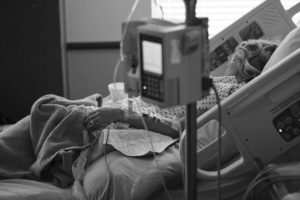- Calls to this hotline are currently being directed to Within Health or Eating Disorder Solutions
- Representatives are standing by 24/7 to help answer your questions
- All calls are confidential and HIPAA compliant
- There is no obligation or cost to call
- Eating Disorder Hope does not receive any commissions or fees dependent upon which provider you select
- Additional treatment providers are located on our directory or samhsa.gov
Anorexia Nervosa: 2020 Research on Long Term Outcomes, Growth Retardation, and Other Medical Consequences

Eating disorders, such as anorexia nervosa (AN), bulimia nervosa (BN), binge eating disorder (BED), and others, have increased in prevalence over the past 25 years. While experts have discussed changes in ideal body image, manufactured foods, and obesity as root causes, these remain puzzling diseases of unknown, but complex bio-psycho-social etiology.
Research has made amazing progress over the past five years. Recent research by the UCSD [1] and UNC [2] groups have helped to inform the importance of hunger and genetics in this disease. This month, research on long term outcomes [3], medical consequences [4] and growth [5] were reported in major, peer-reviewed Journals.
We have tried to divide eating disorders based on symptoms. Clinicians diagnose anorexia nervosa, bulimia nervosa, binge eating disorder, avoidant-restrictive food intake disorder, pica, and rumination disorder.
However, these are not evidence-based diagnoses like DSM-5 Anorexia Nervosa. AN has two subtypes: binge eating, purging, or both, and food restricting only. AN often progresses from one subtype to another, particularly from the restricting subtype to the binging–purging subtype.
DSM 5 Diagnostic [4]
Criteria
Restriction of energy intake relative to requirements, leading to significantly low body weight for the patient’s age, sex, developmental trajectory, and physical health. Significantly low weight is defined as a weight that is less than the minimal healthy weight or, in children and adolescents, less than the minimum healthy weight.
Paradoxical Intense fear of gaining weight or of becoming fat, or persistent behavior that interferes with weight gain, even though the patient has a significantly low body weight.
Disturbance in the way in which one’s body weight or shape is perceived, undue influence of body weight or shape on self-evaluation, or persistent lack of recognition of the seriousness of the current low body weight.
Subtype Designation
Restricting type: During the past three months, the patient has not engaged in recurrent episodes of binge-eating or purging behavior (i.e., self-induced vomiting or the misuse of laxatives, diuretics, or enemas). Weight loss is accomplished primarily through dieting, fasting, excessive exercise, or all of these methods.
Binge-eating and purging type: During the past three months, the patient has engaged in recurrent episodes of binge-eating or purging behavior (i.e., self-induced vomiting or the misuse of laxatives, diuretics, or enemas).
Current Severity
Mildly severe low body weight is defined as a BMI of ≥17.† Moderately severe low body weight is defined as a BMI of 16–16.99. Severe low body weight is defined as a BMI of 15–15.99.
Extremely severe low body weight is defined as a BMI of <15.
Medical Complications of Anorexia Nervosa
Anorexia nervosa is a particularly debilitating and deadly psychiatric disease that compromises social functioning, development, neurological and medical health. AN causes changes in interest in food, eating, and weight disturbed attitudes towards weight, body size, and shape, and eating play a central role in the origin and maintenance of eating disorders.
All organ systems can be compromised by starvation and also by AN. Most are fully reversible with the medical diagnosis, treatment of co-occurring problems, rehydration, refeeding, and time.

While most people think about depression or schizophrenia as the most debilitating and deadly psychiatric diseases, anorexia nervosa is the most deadly. Patients are compromised by starvation and malnutrition, coexisting psychiatric conditions, and treatment resistance.
While body weight and shape are the central features of AN, patients often insist on complete control over everything they eat, how it is prepared, and often claim that they are excellent and successful because everyone else is obese or overweight. Several psychotherapeutic approaches are used; family therapy is commonly used in adolescents [7].
Osteoporosis develops in approximately one of three patients. It can be extremely severe, often predisposing to fractures. Starvation can cause neurological findings, and brain imaging studies show abnormalities (e.g., sulcal widening, ventricular dilatation, and cerebral atrophy). These findings resolve with the restoration of weight. Still, they sometimes persist.
In patients who purge and induce vomiting, this behavior can cause salivary-gland hypertrophy and elevated levels of serum amylase. They also may have delayed gastric emptying, postprandial fullness, and bloating.
Patients are at a real risk of death from medical illness, complications of starvation, and suicide. Indications for hospitalization include profound dehydration, hypotension, severe electrolyte abnormalities, arrhythmias, and profound bradycardia. AN patients are also hospitalized because of suicide risk.
Finally, admission, even in the absence of behavioral distress, is often an emergency when the patient’s body-mass index is 15 or less. The suicide risk among patients with anorexia is high, with an estimated incidence that is 18 times as high as that in controls.
Females with AN have an average premorbid height when adolescence, but the disease changes growth trajectory. So, while AN patients’ height starts, as usual, linear growth retardation is a prominent feature of their illness. Weight restoration is associated with catch-up growth, but complete catch-up is often not achieved [8].
Extremely serious anorexia nervosa is defined as meeting DSM-V diagnostic criteria for AN and having a BMI < 15 kg/m2 in those. Low bone mineral density is so common in this population that it is seen in almost all.
Approximately one-half of these individuals have osteopenia, and 43% have osteoporosis. 35% of severe AN individuals develop hypophosphatemia, and 38% develop hypoglycemia. Both are more frequent in the restricting than a binge-purge subtype of AN.
“Girls with the eating disorder anorexia nervosa may have stunted growth,” researchers concluded in an August 2020 study that included “255 girls around age 15 who were hospitalized for anorexia nervosa.” After measuring “patients’ height at the time of hospitalization and again at adulthood,” investigators found that “the women’s adult height was much shorter than expected compared with the genetic potential gauged by their parents’ height [9].”
Outcomes
Outcome studies show the persistence of coexisting psychopathology. Hospitalizations can also help remove the patient from a triggering environment, a toxic mealtime environment, and troubled relationships.

A recent study has followed people with adolescent-onset anorexia nervosa and matched comparison participants prospectively for 30 years [10]. Later age at onset among individuals with adolescent-onset anorexia nervosa predicted good outcome.
Premorbid perfectionism was a favorable prognostic factor even though premorbid perfectionism was previously thought to be a risk factor for developing anorexia nervosa. Hospitalization was associated with 1.99 times the risk of stillbirth, 1.69 times the risk of low birth weight, and 1.52 times the risk of small-for-gestational-age birth. Infants are primarily at risk of stillbirth, preterm birth, low birth weight, and small-for-gestational-age birth [11].
AN recovery is not linear. Relapses and slips and struggles are part of the recovery process. Recovery is gradual, even when the AN patient is making progress.
A recent long-term follow-up study showed recovery in approximately 31% of patients at nine years, but in almost two-thirds of patients by 22 years of follow up. Long-term 20-year outcome studies suggest full remission occurs in AN in approximately 30 to 60% of patients.
The incidence of relapse after treatment is quite wide-ranging from 9% to 52%, with most studies showing a relapse rate of at least 25%. Anorexia nervosa is associated with high mortality, with aggregate deaths nearing 5.6% per decade.
Research progress is accelerating, and new biological tests, evidence-based neurobiologically based diagnoses, brain imaging, treatment refeeding protocols, and new pharmacological treatments will be discovered and change what we currently know and believe about AN.
Resources:
1. https://health.ucsd.edu/news/releases/Pages/2020-03-12-how-brain-biology-promotes-starvation-in-patients-with-anorexia.aspx
2. https://www.med.unc.edu/psych/eatingdisorders/research/completed-research-studies/anorexia-nervosa-genetics-initiative-angi/
3. Gibson D, Watters A, Cost J, Mascolo M, Mehler PS. Extreme anorexia nervosa: medical findings, outcomes, and inferences from a retrospective cohort. J Eat Disord. 2020;8:25. Published 2020 Jun 23. doi:10.1186/s40337-020-00303-6
4. Mitchell JE, Peterson CB. Anorexia Nervosa. N Engl J Med. 2020;382(14):1343-1351. doi:10.1056/NEJMcp1803175
5. Dalit Modan-Moses, MD, Amit Yaroslavsky, MD, Orit Pinhas-Hamiel, M.D, Yael Levy-Shraga, M.D, Brigitte Kochavi, RD, Sharon Iron-Segev, ScD, RD, Adi Enoch-Levy, MD, Anat Toledano, RN, Daniel Stein, MD, A Prospective Longitudinal Assessment of Linear Growth and Adult Height in Female Adolescents with Anorexia Nervosa, The Journal of Clinical Endocrinology & Metabolism, dgaa510, https://doi.org/10.1210/clinem/dgaa510
6. https://www.ccjm.org/content/87/3/172
7. Mitchell JE, Peterson CB. Anorexia Nervosa. N Engl J Med. 2020;382(14):1343-1351. doi:10.1056/NEJMcp1803175
8. Dalit Modan-Moses, MD, Amit Yaroslavsky, MD, Orit Pinhas-Hamiel, M.D, Yael Levy-Shraga, M.D, Brigitte Kochavi, RD, Sharon Iron-Segev, ScD, RD, Adi Enoch-Levy, MD, Anat Toledano, RN, Daniel Stein, MD, A Prospective Longitudinal Assessment of Linear Growth and Adult Height in Female Adolescents with Anorexia Nervosa, The Journal of Clinical Endocrinology & Metabolism, dgaa510, https://doi.org/10.1210/clinem/dgaa510
9. Dalit Modan-Moses, MD, Amit Yaroslavsky, MD, Orit Pinhas-Hamiel, M.D, Yael Levy-Shraga, M.D, Brigitte Kochavi, RD, Sharon Iron-Segev, ScD, RD, Adi Enoch-Levy, MD, Anat Toledano, RN, Daniel Stein, MD, A Prospective Longitudinal Assessment of Linear Growth and Adult Height in Female Adolescents with Anorexia Nervosa, The Journal of Clinical Endocrinology & Metabolism, dgaa510, https://doi.org/10.1210/clinem/dgaa510
10. Dobrescu SR, Dinkler L, Gillberg C, Råstam M, Gillberg C, Wentz E. Anorexia nervosa: 30-year outcome. Br J Psychiatry. 2020;216(2):97-104. doi:10.1192/bjp.2019.113
11. Ante Z, Luu TM, Healy-Profitós J, et al. Pregnancy outcomes in women with anorexia nervosa. Int J Eat Disord. 2020;53(5):403-412. doi:10.1002/eat.23251
About the Author:

Dr. Gold was the first Faculty from the College of Medicine to be selected as a University-wide Distinguished Alumni Professor and served as the 17th University of Florida’s Distinguished Alumni Professor.
Learn more about Mark S. Gold, MD
The opinions and views of our guest contributors are shared to provide a broad perspective of eating disorders. These are not necessarily the views of Eating Disorder Hope, but an effort to offer a discussion of various issues by different concerned individuals.
We at Eating Disorder Hope understand that eating disorders result from a combination of environmental and genetic factors. If you or a loved one are suffering from an eating disorder, please know that there is hope for you, and seek immediate professional help.
Published on September 1, 2020.
Reviewed & Approved on September 1, 2020, by Jacquelyn Ekern MS, LPC
Published on EatingDisorderHope.com
